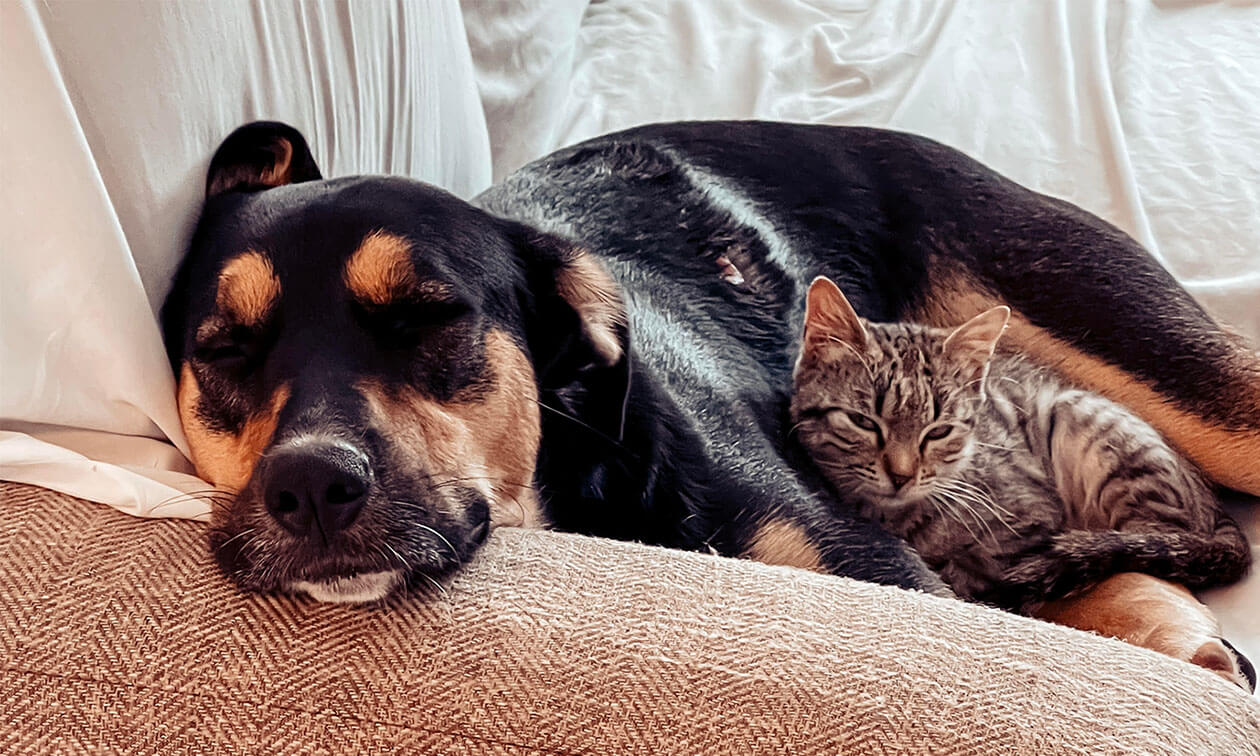Considering adding a dog to your cat-friendly home? Do you dream of a harmonious household where dogs and cats coexist in perfect harmony? Well, you're not alone. Many pet lovers wonder if dogs and cats can get along, and the good news is that they can.
Dog Breeds That Are Good With Cats
Dogs and cats can get along with each other in the same household. However, it’s important to know that most times this depends on the individual dog and cat and their temperament and training. So, dogs that get along with cats can really come in any shape or form if they have the right training and socialization, but these particular breeds have a good reputation of getting along with cats.
Labrador Retriever
The Lab is not only one of the most popular dog breeds but is also known for their friendly and easygoing nature. Labs typically have a low prey drive and are often welcoming to cats when properly introduced. However, keep in mind that playful Labradors might get a little too excited for some delicate feline tastes.
Golden Retriever
Like their Lab counterparts, Golden Retrievers are renowned for their sweet and gentle disposition. With their patient and friendly nature, Goldens can make great companions for cats. Just remember to supervise their interactions, especially during the initial stages of their relationship.
Cavalier King Charles Spaniel
With their affable and sociable nature, Cavalier King Charles Spaniels often get along well with cats. Their small size and gentle temperament make them less likely to intimidate feline friends. Introduce them correctly, and you may witness a beautiful friendship blossom between your Cavalier and cat!
Beagle
Beagles are known for their merry and sociable personalities. They have a strong instinct for tracking scents and may be more prone to chasing cats than some other breeds on this list. That said, with proper training and early socialization, they can learn to coexist peacefully with cats. Slow introductions and positive reinforcement are key for a harmonious household.
Bichon Frise
The Bichon Frise is a charming and affectionate breed that can often form close bonds with cats. Their friendly, non-aggressive nature makes them good candidates for a successful inter-species companionship. However, as with any breed, it's important to supervise their interactions and provide proper guidance.
Breed Types That Get Along with Cats
Certain breed types are naturally more inclined to get along with cats. Toy breeds, like Papillons and Pugs, were bred to be lap dogs and companions, so they’re friendly and sociable. Sporting breeds, like different kinds of Retrievers and Spaniels, are friendly and outgoing and may like cats so much that they try to play.
Other breed groups, like Terriers and Sighthounds, might have a harder time getting along with cats. Terrier breeds were created to hunt vermin and are instinctually more inclined to chase small animals like cats. Sighthounds, like Basenjis and Italian Greyhounds, were bred to chase game over long distances and may be excited to chase a cat around your home.
Are There Specific Cat Breeds That Are Good with Dogs?
Most cats in homes today are a mix of many breeds, making breed less relevant for cats than it is for dogs. There are some breeds that tend to be a bit more energetic, anxious, or mellow than others, but cat breeding focuses more on appearance than any other characteristics.
How Can Dogs and Cats Get Along?
Now that we've explored some dog breeds that tend to get along with cats, it's crucial to emphasize that any dog can potentially have a harmonious relationship with a cat. Breed alone does not determine the success of their coexistence. Dogs that are good with cats usually have at least one of the following.
Personality
The most important factor in is an individual dog and cat’s personality. Regardless of breed or mix, each animal is an individual. A dog’s breeding can help give you an idea of what their personality might be like, but environmental factors, age, and health can affect a dog’s personality. Who knows – your dog might love cats, but your cat is the culprit for the rift in their relationship.
Low Prey Drive
Certain breeds have an instinctual need to chase and hunt small animals. Rat Terriers, for example, were bred to hunt rats and other small animals on farms. They have a high prey drive, so it makes sense that they might chase and otherwise not get along well with cats. Other breeds with a high prey drive will likely have similar issues with small animals The size of a dog breed can also be a factor with low prey drive. A larger dog breed may act aggressive with being playful, but this can accidentally hurt a cat easier than if a small breed dog acted the same way. So, a breed like a Boxer or Bull Terrier could accidently hurt a cat easier than a smaller or less powerful dog.
Dogs that have prey drive could unintentionally cause stress to a cat with behaviors like chasing a cat while playing. This can lead to the cat having anxiety and escaping the house out of fear of being chased.
Toy breeds such as Shih Tzu frequently are bred to have a low prey drive and may be less likely to chase a cat.
Training and Socialization
Training, socialization, and proper introductions are key to fostering a positive relationship between cats and dogs. A slow, thoughtful introduction is important. Remember to watch their body language closely, provide positive reinforcement, and, most importantly, consult with a veterinarian or professional dog trainer for personalized advice. Talk to your veterinarian your dog’s body language so you can differentiate play behavior from aggressive behavior and can set the right boundaries for your pets.
Working with a certified feline behaviorist can be incredibly helpful, especially if your cat is naturally a bit on the anxious side or has a history of negative experiences with other animals.
Adopt a Younger Dog
Often, the best way to have a harmonious cat-dog home is to introduce the cat and dog when the dog is under a year old. This way, the dog grows up viewing the cat as a part of their core social group and is less likely to view them as prey.
No matter what age you introduce dogs and cats to each other, going very slow, providing high levels of separation, and implementing safety management is key. Talk to your vet about the safest way to do this.
Even if a dog or cat has successfully lived with the other species before, that doesn’t necessarily mean they will do well with another canine or feline housemate. Every animal is an individual!
No matter which dog or cat breed you have, with patience, understanding, and love, you can create a home where dogs and cats live together in harmony.
ZPC-02715



